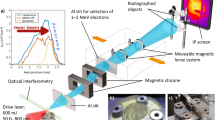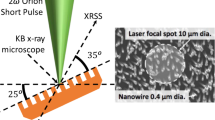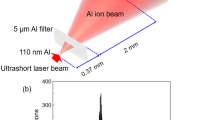Abstract
Stripping heavy atoms in solid matter of most of their electrons requires the extreme conditions that exist in astrophysical plasmas, but are difficult to create in the laboratory1,2,3. Here we demonstrate solid-density gold plasmas with atoms stripped of up to 72 electrons (N-like Au72+) over large target depths. This record ionization is achieved by irradiating solid foils and near-solid-density nanowire arrays with highly relativistic (3 × 1021 W cm−2) second-harmonic femtosecond laser pulses of <10 J energy focused into a 1.6 µm spot. The short wavelength and high intensity enable the interaction to occur at a relativistic critical density4,5 of 1023 cm−3. Solid targets reach a higher average charge in 1- to 2-µm-thick layers, while the less dense nanowire plasmas are heated to much larger depths (>8 µm) by energetic electrons generated near the nanowire tips. Larger laser spots could result in solid Au plasmas ionized up to He-like.
This is a preview of subscription content, access via your institution
Access options
Access Nature and 54 other Nature Portfolio journals
Get Nature+, our best-value online-access subscription
$29.99 / 30 days
cancel any time
Subscribe to this journal
Receive 12 print issues and online access
$209.00 per year
only $17.42 per issue
Buy this article
- Purchase on Springer Link
- Instant access to full article PDF
Prices may be subject to local taxes which are calculated during checkout




Similar content being viewed by others
Data availability
The data that support the plots within this paper and other findings of this study are available from the corresponding authors upon reasonable request.
Code availability
The computer programs that support the findings of this study can be made available upon reasonable request to the corresponding authors.
References
Heeter, R. F. et al. Benchmark measurements of the ionization balance of non-local thermodynamic-equilibrium gold plasmas. Phys. Rev. Lett. 99, 195001 (2007).
Foord, M. E. et al. Ionization processes and charge-state distribution in a highly ionized high-Z laser-produced plasma. Phys. Rev. Lett. 85, 992–995 (2000).
May, M. J. et al. X-ray spectral measurements and collisional-radiative modeling of hot, gold plasmas at the omega laser. High Energy Density Phys. 4, 78–87 (2008).
Kaw, P. & Dawson, J. Relativistic nonlinear propagation of laser beams in cold overdense plasmas. Phys. Fluids 13, 472–481 (1970).
Palaniyappan, S. et al. Dynamics of relativistic transparency and optical shuttering in expanding overdense plasmas. Nat. Phys. 8, 763–769 (2012).
Träbert, E. et al. L-shell spectroscopy of Au as a temperature diagnostic tool. Rev. Sci. Instrum. 79, 10E313 (2008).
Brown, G. V. et al. Investigation of the 2p3/2−3d5/2 line emission of Au53+–Au69+ for diagnosing high energy density plasmas. Phys. Rev. E 77, 066406 (2008).
Akli, K. U. et al. Laser heating of solid matter by light-pressure-driven shocks at ultrarelativistic intensities. Phys. Rev. Lett. 100, 165002 (2008).
Hoarty, D. J. et al. Observations of the effect of ionization-potential depression in hot dense plasma. Phys. Rev. Lett. 110, 265003 (2013).
Chen, S. N. et al. X-ray spectroscopy of buried layer foils irradiated at laser intensities in excess of 1020 W/cm2. Phys. Plasmas 16, 062701 (2009).
Purvis, M. A. et al. Relativistic plasma nanophotonics for ultrahigh energy density physics. Nat. Photon 7, 796–800 (2013).
Kulcsar, G. et al. Intense picosecond X-ray pulses from laser plasmas by use of nanostructured ‘Velvet’ targets. Phys. Rev. Lett. 84, 5149–5152 (2000).
Nishikawa, T. et al. Nanocylinder-array structure greatly increases the soft X-ray intensity generated from femtosecond-laser-produced plasma. Appl. Phys. B 73, 185–188 (2001).
Ovchinnikov, A. V. et al. Characteristic X-rays generation under the action of femtosecond laser pulses on nano-structured targets. Laser Part. Beams 29, 249–254 (2011).
Mondal, S. et al. Highly enhanced hard X-ray emission from oriented metal nanorod arrays excited by intense femtosecond laser pulses. Phys. Rev. B 83, 035408 (2011).
Hollinger, R. et al. Efficient picosecond X-ray pulse generation from plasmas in the radiation dominated regime. Optica 4, 1344–1349 (2017).
Wang, Y. et al. 0.85 PW laser operation at 3.3 Hz and second-harmonic beamline. Opt. Lett. 42, 3828–3831 (2017).
Kaymak, V., Pukhov, A., Shlyaptsev, V. N. & Rocca, J. J. Nanoscale ultradense Z-pinch formation from laser-irradiated nanowire arrays. Phys. Rev. Lett. 117, 035004 (2016).
Levy, M. C., Wilks, S. C., Tabak, M., Libby, S. B. & Baring, M. G. Petawatt laser absorption bounded. Nat. Commun. 5, 4149 (2014).
Weibel, E. S. Spontaneously growing transverse waves in a plasma due to an anisotropic velocity distribution. Phys. Rev. Lett. 2, 83–84 (1959).
Rosmej, O. N. et al. Generation of keV hot near-solid density plasma states at high contrast laser-matter interaction. Phys. Plasmas 25, 083103 (2018).
Sánchez del Rı́o, M., Faenov, A. Y., Pikuz, T. A., Souvorov, A. & Freund, A. K. Hard X-ray reflectivity of spherically bent mica crystals. AIP Conf. Proc. 521, 287–2292 (2000).
Pukhov, A. & Meyer-ter-Vehn, J. Laser hole boring into overdense plasma and relativistic electron currents for fast ignition of ICF targets. Phys. Rev. Lett. 79, 2686–2689 (1997).
Shlyaptsev, V. N., Rocca, J. J. G. & Osterheld, A. L. Dynamics of a capillary discharge X-ray laser. Proc. SPIE 2520, 365–372 (1995).
Bar-Shalom, A., Klapisch, M. & Oreg, J. HULLAC, an integrated computer package for atomic processes in plasmas. J. Quant. Spectrosc. Radiat. Transf. 71, 169–188 (2001).
Karmakar, A. & Pukhov, A. Collimated attosecond GeV electron bunches from ionization of high-Z material by radially polarized ultra-relativistic laser pulses. Laser Part. Beams 25, 371–377 (2007).
Zhidkov, A. & Sasaki, A. Effect of field ionization on interaction of an intense subpicosecond laser pulse with foils. Phys. Plasmas 7, 1341–1344 (2000).
Acknowledgements
The experiments were conducted using the Colorado State University ALEPH laser facility supported by LaserNet US (DE-SC0019076). The work was supported by Fusion Energy Sciences (FES), Office of Science, of the US Department of Energy (DOE) (grant no. DE-SC0014610). R.H. was supported by the US DOE FES Postdoctoral Research Program administered by the Oak Ridge Institute for Science and Education (ORISE) for the DOE. ORISE is managed by Oak Ridge Associated Universities (ORAU) under DOE contract number DE-SC0014664. All opinions expressed in this paper are the author's and do not necessarily reflect the policies and views of DOE, ORAU or ORISE. The simulations were conducted using the Colorado University/Colorado State University Summit High Performance Computer System, National Science Foundation (ACI-1532235). We acknowledge the assistance of T. Kaiser in running the PIC code.
Author information
Authors and Affiliations
Contributions
The concept of the experiment was proposed by R.H. and J.J.R. and the experiment was designed by R.H., Y.W., S.W. and J.J.R. Modelling was performed by V.N.S., R.H., V.K. and A.P. The experiments were conducted by R.H., A.M., S.W., Y.W., H.S. and A.R. The targets were developed and manufactured by M.G.C., E.B. and R.H. All authors participated in the writing of the manuscript.
Corresponding authors
Ethics declarations
Competing interests
The authors declare no competing interests.
Additional information
Publisher’s note Springer Nature remains neutral with regard to jurisdictional claims in published maps and institutional affiliations.
Extended data
Extended Data Fig. 1 Simulated Au spectrum.
Simulated Au spectrum corresponding to solid flat gold target irradiated at an intensity of 4×1021 Wcm−2. Best agreement with the experimental spectrum is obtained when lines from F-like to N-like Au are shifted down in energy by ~0.4%. Similar shifts were necessary in ref. 7 when comparing the calculated Au line energies with the measurement. The spectrum was computed using transient calculations performed with the atomic physics/hydrodynamic code RADEX using initial plasma parameters computed by the PIC simulations. The RADEX code uses detailed atomic data from the Hebrew University Lawrence Livermore Atomic Code (HULLAC) (ref. 25). It was run using 200 to 1500 levels per ion from Cu-like (Au50+) to B-like (Au74+) to accurately simulate the large number of transitions from the L shell configuration. The simulated spectrum shows emission of all the observed lines for charge states from Ne-like to N-like Au.
Extended Data Fig. 2 Ratio of X-ray emission between nanowire and solid-density targets.
Ratio of X-ray emission at photon energies > 1 keV from an Au nanowire target (100 nm diameter nanowire array, 15 % solid density) to Au solid foil target as a function of irradiation intensity.
Extended Data Fig. 3 Computed electron energy density.
Computed electron energy density for an array of 100 nm diameter Au nanowire array (15% solid density) plotted for three different times with respect to the peak of the laser pulse (−30fs, 0 fs and +160 fs). Irradiation intensity 4x1021 Wcm−2.
Extended Data Fig. 4 High-resolution 3D particle in cell simulation of solid-density ionization.
Predicted ionization stage for an infinite (periodically bounded in the transverse direction) solid Au flat target at +30 fs following the peak of the laser pulse.
Extended Data Fig. 5 Computed ionization for a 5 micron diameter laser spot.
Computed ionization state as a function of target depth for a solid-density Au foil irradiated at an intensity of 4x1021 Wcm−2 with a 5 μm FWHM diameter focal spot showing atoms ionized up to He-like Au77+.
Extended Data Fig. 6 Shot to shot reproducibility.
Three consecutive single shot Au L shell spectra from an Au foil normalized by the Ne-like Au line emission showing good shot to shot reproducibility.
Extended Data Fig. 7 Ge K-shell spectrum used to calibrate Au L-shell.
K-shell spectrum of the Ge plasma used to calibrate the Von Hamos spectrometer in the 9.7–11.2 keV spectral range. The plasma was generated irradiating a 17 μm thick Ge wafer at an intensity of 3x1021 W cm−2.
Rights and permissions
About this article
Cite this article
Hollinger, R., Wang, S., Wang, Y. et al. Extreme ionization of heavy atoms in solid-density plasmas by relativistic second-harmonic laser pulses. Nat. Photonics 14, 607–611 (2020). https://doi.org/10.1038/s41566-020-0666-1
Received:
Accepted:
Published:
Issue Date:
DOI: https://doi.org/10.1038/s41566-020-0666-1
This article is cited by
-
High-flux bright x-ray source from femtosecond laser-irradiated microtapes
Communications Physics (2024)
-
Extreme focusing of hard X-ray free-electron laser pulses enables 7 nm focus width and 1022 W cm−2 intensity
Nature Photonics (2024)
-
Intense laser interaction with micro-bars
Scientific Reports (2023)
-
Charge-state resolved laser acceleration of gold ions to beyond 7 MeV/u
Scientific Reports (2022)
-
Extreme ionization of gold atoms
Nature Photonics (2020)



